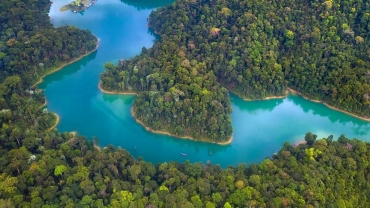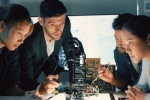
Episode 4: Building Resilient Communities
Subscribe to our podcast
In this episode, we look at some real-world examples of how communities that heavily rely on high-emitting industries for employment and incomes can move away from being negatively impacted by both climate change and climate adaptation strategies and towards increased resilience and active participation in the green economy.
Release date: October 6, 2023
Full transcript
Ivy Kuo:Hello. I'm Ivy Kuo, Asia Pacific's ESG leader at PwC. You're listening to ESG: Defining Asia Pacific's Future. This podcast series provides insights on the latest sustainability trends in the region to help you solve today's challenges and prepare to take on tomorrows.
In the second session, we focus on Asia Pacific's just transition to net zero. I'm delighted to introduce you to PwC's expert in this topic, Kirsty Haymon.
Kirsty Haymon:Thanks, Ivy, for the introduction. There's an increasing call to action to ensure that the shift to net zero is fair and inclusive. In this second season, we'll be exploring how stakeholders can achieve an environmentally sustainable global economy while also ensuring no one gets left behind.
We have a great lineup of speakers covering topics from energy, justice, and human rights to community resilience and workforce transformation. Our guests will be sharing their views on Asia Pacific's just transition, and the strategy is being deployed in the region to drive inclusive opportunities for those most impacted by the shift away from carbon-intensive activities.
Please note that the opinions expressed in this podcast are solely those of the speakers, and do not reflect the views or opinions of any organisations with which they may be affiliated. Let's get started!
Welcome to our fourth podcast. We've heard in our previous discussions about the actions that energy companies are taking as part of their decarbonization strategies towards ensuring no one is left behind. We've also discussed the implications of both public and private sector approaches towards net zero on workforces, and what considerations should be factored to ensure the most vulnerable in our communities are enabled to benefit from the energy transition.
In this episode, we'll touch upon examples of how communities reliant on heavy emitting sectors for jobs and incomes can shift away from being impacted by both climate change and climate adaptation measures towards increased resilience and active contribution to the green economy.
Before I introduce my guests, I'd like to acknowledge the traditional lands of the Kaurna peoples from which I speak to you today, and pay my respects to their elders past, present, and emerging.
With me, I have three colleagues from PwC Australia's Indigenous Consulting (PIC), a majority owned, led and staffed Indigenous operation.
Sharing their knowledge and insights today are Gavin Brown, chief executive officer and Wiradjuri man, Kate Healy, partner at PIC, and Steve Stanton, director and Gomeroi man. Many thanks to you all for your time today.
Kate, as a starting point for today's conversation, can you take us through what you've described recently as this passive relationship between First Nations communities and the energy sector?
Kate Healy:Thanks, Kirsty. I think, for many years, First Nations communities in Australia have been viewed as very much passive participants in the economy generally, and the energy sector is one of those elements of the economy.
First Nations people are consumers, but not often considered to be potential investors or participants in the generation, storage, distribution of energy. I think that the energy transition really provides an opportunity to change that narrative and that perception of First Nations communities and organisations across the country.
Kirsty:What, from a principles approach, is needed to shift towards more active engagement between these decarbonization activities that are happening at an increasing rate in Australia and our remote and Indigenous communities?
Kate:From a principles perspective, I think that there's three or four that are really going to be important. The first of those is early and consistent engagement. It's really key to make sure that First Nations communities' diverse needs and objectives are being recognised.
You only uncover those through deep and ongoing conversations and engagement with communities. Adequate time and resources need to be invested to make sure that engagement occurs, and it's not a one-off thing, but an ongoing process of engagement and creation of relationships.
First Nations decision making is also going to be really key. First Nations people need to be part of and lead decisions that affect their communities. To be truly self-determined, First Nations people need to have the time and space, and to have decision-making powers and the ability to influence matters that are relating to their affairs in relation to the energy economy.
That's going beyond consultation and finding opportunities to co-design, co-govern, and co-manage. Really making sure that things are not being done to First Nations communities but being done with First Nations communities as part of that decision-making process.
Then, the third really important principle is that we're ensuring that we're privileging First Nations economic and social interests. If we want to truly close the gap in Australia, First Nations people need to generate greater individual and collective wealth and be financially secure. The energy economy provides an opportunity for us to be bold and take steps to really be privileging those interests.
Kirsty:Thanks, Kate. I think a lot of what you've just pointed out probably resonates into the region as well. Indigenous communities are not solely related to Australia and the Australian context. Indonesia, for example, will have very similar issues and challenges to overcome.
What are the opportunities here to really try and push this towards greater inclusivity and equality?
Kate:The opportunities are huge. First Nations communities and organisations have opportunities to be investors, to be proponents of projects on their own land that relate to the energy transition. Their workforces that are in place and available to be trained, not only in the build of energy transition projects, but also, really importantly, in the servicing and maintaining of them into the future.
One of the real risks is that we go through this energy transition process, and lead technology and equipment delivering energy that can't be serviced and looked after. If those things are in remote communities, and those communities are entirely relying on this new technology and it breaks, then how do we get servicing and materials out to help support that?
There are roles for participation, and really active participation, across that spectrum, from employment and advice through to ownership, and being the idea generator behind the project as well. First Nations communities know what they want. They know what they need on their land. They need to be listened to, and then given the time and the space to really drive projects that are going to benefit their communities now and into the future.
Kirsty:Gavin, just turning to you ... I know you and the team have been working on a number of projects really implementing what Kate is talking about, in terms of both ensuring Indigenous participation in direct workforce but also in those indirect workforces through supply and value chains.
Can you give us a couple of examples where those principles that Kate mentioned around active participation and First Nations being consulted with that really demonstrate what can be achieved?
Gavin Brown:Yeah. Sure. Thanks, Kirsty. I think, firstly, the context in Australia in relation to the region is that the consciousness has shifted quite a bit over the last, let's say, ten years. From, as Kate said, really passive participants to people working up to this new Indigenous industry, Indigenous communities, people in rural and remote Australia having more of an appetite to get involved and these types of things.
With that, it's been coupled with some emergence of capital and different forms of capital in Australia that really shifted the dial in these spaces. Off the back of that, we see large proponents in these large capital-intensive industries now reaching out for assistance with things like an independent assessment of their relationships between proponents and the traditional owners, the local landowners. Being involved in assessing what those things might look like, and we have investors and financiers asking for that sort of independence, asking for a separate view on what those things might look like, in fact.
Then as communities mature, as the relationships mature here in Australia, what we're seeing is an opportunity for people to be a bit more proactive. The Mirning group in the border of South Australia and Western Australia look at a large multi-billion dollar solar and wind proposition with a South Korean group, amongst others. We have inbound investment from the region that are seeing the opportunity here to work with First Nations peoples upfront, so we're seeing that.
Yindjibarndi group announced just publicly in the last couple of weeks, a group out of the Philippines, working with them to talk about access, governance, shared benefits, shared value, how they might get 25% to 50% interest in each of any propositions as they come to light.
Those things have shifted. We wouldn't have seen that past even three, certainly not five years ago. We're now seeing those sorts of things happen. We're seeing that shift quite markedly.
Kirsty:There's a natural benefit of engaging with First Nations communities, given their affinity with land and other natural resources.
I think we've talked recently about one of your research pieces around the shift and contribution of Indigenous communities towards Australia's GDP. I think, back in 2016, it was about$6.6 billion, and, since then, in 2021, it shifted towards $12 billion. Something is happening in the background to enable this increased engagement.
This really, I think, from what you've said, is being driven by the private sector. What lessons have been learned along the way that you could share or encourage other private sector companies to really push forward?
Gavin:When we talked to larger private sector players, we're seeing that maturity unfold as well. So, groups that used to talk about corporate social responsibility maybe 10, 15 years ago, and then used to talk about social licence to operate maybe five years ago, a lot of them have really shifted into this social value space, so, understanding that they operate on someone else's country. There is a need for a respectful way of doing business. I'm sure that's the same anywhere in the region.
What we're seeing now is the closest link, certainly our experience, that we've seen between social value and enterprise value. These sorts of conversations occurring at the C level and in the strategy space, not in the community space.
That, in terms of sustainable advantages between private sector players, those that we see do that well are seeing it very clearly as a way in which to generate sustainable advantage over others. How do they secure a foothold? How do they secure assets? How do they secure talent? All these things, social value is a real way to drive those sorts of things.
Kate:I think the other side to that coin, also, is that they're seeing the risk of not doing it properly. That, by really genuine and ongoing engagement, it's an opportunity to fast-track projects, to move them through consenting, to get things moving forward in the most efficient and effective way by working in partnership with traditional owners and First Nations people.
Kirsty:Absolutely. Are you seeing anything around the use, or more creative use around Indigenous land use agreements and the application of carbon credits? Are we seeing that take place here in Australia?
Gavin: Certainly land use agreements. We're starting to see alternatives to land use agreements, which are subject to the Native Title Act here in Australia federally, across the country, and have a formulaic way of unfolding that can make sense in lots of situations. Though we are starting to see the green sprouts of voluntary agreements outside of the land use agreement space, where a private sector proponent and local groups decide.
Like Yindjibarndi case, what's happening in that case is that the Yindjibarndi people have themselves built their capacity over the last 20 years. They built their own regional plan. "This is what we want for our region." Then, with that planning and that capability, they can then go to market to say, "We want to do these things on our land. What do you think, market?"
We're starting to see this market driving things are moving ahead of some of the more traditional land use agreement spaces. I think that's certainly one of the things I'm seeing.
Kirsty:Steve, let me bring you into this conversation as well, because you've recently joined PIC from a social impact fund. You have some real, tangible experience in identifying and enabling this capital to reach First Nations people.
From a financial and investment perspective, what role could, or perhaps should, the private sector be taking to really enable the capital that Gavin is talking about, to really being driven in the right direction and generate those wider social impacts?
Steve Stanton:Thanks, Kirsty. I think, first, we need to understand what the gap in capital is. Recent estimates suggest that there's about a two billion gap in investment for First Nations led initiatives, and that's just in the energy transition space.
I think it's telling that Indigenous people their relationship with capital has been very patchy intergenerationally.
I think understanding and working within the realms of self-determination and really understanding what that means to Aboriginal and Torres Strait Islander people. Economic independence is something that Indigenous people are striving for.
I also think, around that theme of relationships, it's important that the private sector starts to understand Indigenous ways of knowing and being, and what relationships are and where they sit with us. That is the same with investment. We hold relationships at the centre of what we do and who we are.
I think reframing investment is really important to the Indigenous economy. Understanding that shared value does look different for Indigenous people, and what we're trying to aim and achieve. With that reframing of value and relationships in the market and investment to Indigenous organisations, I think we'll see a real shift in the way that capital does flow.
With that, as well, we're starting to see some real activity. I did a quick review of 15 private sector investors in the energy transition space. 13 out of the 15 investors had Indigenous or First Nations engagement as a priority, so I think that's really exciting to see.
I think the next step is, what does the practical implementation of that look like? We're starting to see a review now of the Sustainable Finance Taxonomy in Australia, and First Nations people need to be part of that conversation. I think setting those really clear strategies up, genuine engagement based on relationship is going to be the first step to get the capital flowing in the right direction.
Kirsty:What that also requires is new ways of looking at startup capital and venture enterprises. There's some real limitations here around how that capital can reach small to medium enterprises that are owned by First Nations people.
What are the challenges there? Again, what can the private sector be doing or helping to enable to really ensure that this wider distribution of benefits is reaching these rural communities?
Steve:Again, a challenging question, but topical. I think the private sector's always been quite innovative and adaptive to the market. Here's another opportunity to be innovative around financial products, particularly when we're investing and working beside Indigenous and First Nations companies, or organisations.
Innovation with the view of being responsive to those things I spoke about before, relationship with Indigenous people, relationship with country, whilst achieving the economic priorities and the transition to net zero. Innovation in terms of looking at blended capital finance I think plays a really important part in building the infrastructure and the supply chain for our communities, blended capital being described as more patient forms of capital.
I think one of the key barriers for investment at the moment, and it's probably mainly driven by the macroeconomic conditions globally that we're in, is capital seems to be becoming more impatient. Many people are looking for quick wins and yields rather than long-term, sustainable, relationship-based investment.
I think there is a real opportunity there to explore the patience of capital when investing in some of these projects with First Nations people. We need to also look at what does risk mean when we're taking on these types of investments and encourage the private sector to reassess what risk looks like for them, particularly investing in the Indigenous economy and some of the infrastructure projects around the energy transition and decarbonization.
I think priority alignment is really important. Is that bringing Indigenous people in to talk at the table, when we're looking at what investment strategies the private sector can contribute to or are developing. Kate mentioned, I think, earlier on, as First Nations people, we don't want things to be done to us, we want to be part of the conversation around planning on how they're designed.
I think it's really time for the private sector and First Nations people to engage together to look at ... How do we address some of the complex and emerging issues, like moving towards net zero, and the role that we play in that? Having a seat at the table, ensuring that our priorities are clearly aligned and there's genuine partnerships and relationships formed I think is going to go a significant way to addressing that gap in accessing capital.
Kirsty:Thanks, Steve. A question to all of you, really. Beyond just finance, what else needs to be enabled to get this relationship right? Here I'm thinking of aspects around capacity building within First Nations communities or enterprises, perhaps the need for data to measure this impact and make sure what we assume is happening is actually the reality.
Gavin, can I just start with you in terms of this wider enabling environment?
Gavin:Certainly, as Steve and Kate were saying, where the private sector is showing interest, we're seeing opportunities in the supply chain with Indigenous businesses. The issue is often scale. What does the supply look like, and how do you build on that supply?
We've seen different models for that. Kate's been involved with a scale-up proposition in Vic, just testing out different models of getting Indigenous businesses to scale up. We've looked at smaller Indigenous businesses in a position with the right counterparties, and the right clients, and the right support from the private sector being able to look at acquisitions themselves, to scale up. Then new models themselves, in terms of co-ops, or mutuals, or a blend of different types of organisations.
There's a huge human capital element. The people, actually, I think is going to be one of the more complex issues. In former, previous spaces, in mining, elsewhere, these things were looked at too late. People have to get up to speed really quickly, and it's just unrealistic to expect that to happen.
Certainly, in this space, the human capital element that can connect with the private sector, that can build their own businesses, that can engage in the M&A space is going to be really crucial. I think human capital is something that needs to be absolutely invested in.
Kirsty:Great. Steve, I know you've also worked in that social impact space regionally. You've mentioned before around Indigenous-led non-government intermediaries and the role that they can play. I think, just to take one of Kate's points around what can be learned from different parts of the region and how this can be unfolded to provide examples of where we have similar situations in remote, Indigenous, vulnerable communities.
Steve:There needs to be a flip of looking at our remote communities as utterly disadvantaged. There are so many opportunities. Our elders, business leaders, and cultural leaders in our remote communities understand what needs to be done in those remote communities, whether it's project based, whether it's health education, what type of capital they need in those communities.
I think it's also reframing away from a welfare lens on some of our remote communities. Yes, some of our communities have less access. Yes, it's a lot tougher, but there is so much more opportunity, particularly when we're talking about projects and initiatives that are tackling our ambition towards net zero. I think reframing just that is really important.
I think, ultimately, there's a shared learning space for both the private sector and community to come together genuinely to look at how we tackle this complex issue. I think it doesn't necessarily have to be about the big brother teaching the remote communities, I think it's somewhere in the middle, of community leaders, cultural and business leaders coming together and coming up with the right solutions based on relationships.
Gavin:Just going to riff off the back of the relationship piece, because, given the audience for this podcast, really fascinated by the parallels, particularly traditionally, between Indigenous ways of knowing, and being, and doing and more Eastern philosophies, rather than Western philosophies. Around wellbeing, respect, responsibility, reciprocity, respect for cultures, these sorts of things. It is quite a different lens.
It's really interesting to see some of those bigger deals, actually, are being funded and supported in the early stages by Asia into Australia with First Nations communities. I think that is completely untapped, in that there's a really strong alignment with, I would say, traditional values like collectivism, collective good in Australian Indigenous context, and respect for culture very strongly.
Kirsty:I think you've variously mentioned the issue of welfare and being passive and receiving benefit. In our previous podcast we've had discussions around the timing of some of these activities. If we get this wrong, there's a huge need to fall back on social protections, for example.
Driving action now is actually really important. One of the things I think we need to drive that action or to understand what action is needed is around data. Do we have that level of data to really be making informed decisions in Australia?
Gavin:I think it's mixed. I think it's patchy, to be honest. I would say, generally speaking, we're, with a handful of exceptions, not seeing the pie grown enough and distributed enough to make huge differences at this stage.
Kate:I think I'd agree with that, Gav, in terms of the First Nations economy. We don't have the data that's sufficient to talk to that.
I think what we do have the data about, though, is we know where people are, we know how many people are there, we know the level of need in communities. I think I would be really worried, though, that what the energy transition does is builds for the current state and not the future state. The future state of our remote and regional communities where houses are better and more efficient, there are more of them, there are more people living in those regions.
Let's make sure we build for a prosperous future, not the current state. That data's a little harder to come by, but let's be ambitious.
Steve:I think, just on data, Kirsty, whilst there are a lot of gaps in the available data right now, there's opportunity to build it. Getting back to my point around the opportunity for the private sector to be innovative, looking at things like sustainable linked loans, sustainable linked bonds. Attaching KPIs to outcomes and collecting that data builds, essentially, a scaffold effect of ... Is the capital going to the right areas? Are we getting the right outcomes? That match between measurement of outcomes and impact, but I think driven by what those outcomes and impact are for First Nations communities.
Collecting that data, we start to know what works and what doesn't work. What has capital returned, and does social good and environmental good? I think, within that, we can't just say the data's not available. We also need to look at innovative ways of meeting the needs of today but collecting the information that's going to drive investment for the future.
Kate:And be willing to share that information, too. When it's been collected by the private sector, to share it for the greater good, not retain it for competitive advantage.
Steve:Absolutely. Seeing a massive movement around democratising data and data sovereignty for Indigenous people, I think, is a really important piece of the pie in this discussion as well.
Kirsty:We know that there's a gap here, a window of opportunity. Do we need to be pushing ahead with a sense of urgency when we know that this energy transition in Australia, and obviously in other places in the region, is moving at some speed? Because what is there to be lost for First Nations people, but also, what is there to be gained? How quickly do we need to move to make sure that the latter happens?
Gavin:I think the first point I'd like to make is that we've seen this before in Australia. We saw ag come and go, and still stayed around. That wave of agriculture through the country, and not managed in a, quote, unquote, "just" way. We've seen what's happened off the back of that.
Seen mining coming. Again, another wave that came in Australia that prosperity was not shared uniformly around the country. I'm seeing these eras of prosperity come and go, and the whole notion of a just transition not really being mentioned or be part of the vernacular until the last handful of years. We've seen how social indicators can continue to go backwards without some forethought given to this sort of space.
Things are moving really, really quickly, and so there is a real need to accelerate this, to work out what the just transition looks like, and how it hits the ground and get things lined up quickly for that.
Because, as I think everyone else is saying, the payoff is significant. It's an era of prosperity that is very aligned to Indigenous ways of knowing, being, doing. Looking after your country, renewables, all those sorts of things are really aligned culturally to some large landowners around this country. An opportunity to do that in a way that provides prosperity and helps the planet is hugely exciting, I think, and ready for us.
Kate:Only that this transition is going to occur regardless, so we need to move forward. The world is moving forward to transition how energy is generated, stored, and distributed. If we don't ensure that First Nations people are part of that, someone else is going to be part of that and drive that to their own financial economic prosperity outcome.
Kirsty:Steve, was there anything you wanted to add to that as well, in terms of why we need to be moving ahead as quickly as possible now?
Steve:I think Kate and Gav addressed it very clearly, but what I would say is to continue to encourage the private sector, the investment market to start thinking about its engagement with First Nations people. The projects that Gavin had mentioned are underway, so we're actually participating in this market and we will continue to scale. We're participants at the moment, so that the risk of not participating or not being part of it is probably only if the investment's not there, and the partnerships and relationships aren't there.
I think it is that real opportunity to create that shared value between First Nations people and the private market come together to solve what is a complex problem and is going to benefit all when we do. That's very much aligned to our cultural values as it is for the economic prosperity of Australia and, indeed, globally.
Kirsty:Thanks to you all for your insights today, which I think provide an indication on the extent of the opportunity for the most vulnerable, not just here in Australia, but also as an example of what can be achieved in local communities throughout the region. This is the very essence of what a just transition can and should enable.
The examples shared today prove that real change is possible, given the right conditions. This includes a need for wide and inclusive engagement, relationship building, capital mobilisation, and sharing of industry practice. As these issues will resonate throughout the region, the concepts we've heard about today will demonstrate what can be achieved when the private sector engages closely with owners of traditional knowledge.
Join us for our next and final podcast, which goes further into the role of financial institutions to enable a people-centred energy transition.
© 2023 PwC. All rights reserved. PwC refers to the PwC network and/or one or more of its member firms, each of which is a separate legal entity. Please see www.pwc.com/structure for further details. This content is for general information purposes only, and should not be used as a substitute for consultation with professional advisors.
Contact us


Global Impact Centre – Sustainable Supply Chains, Managing Director, PwC Hong Kong

Managing Director, Global Social Sustainability Lead, PwC Australia
Tel: +61 403 778 293


















